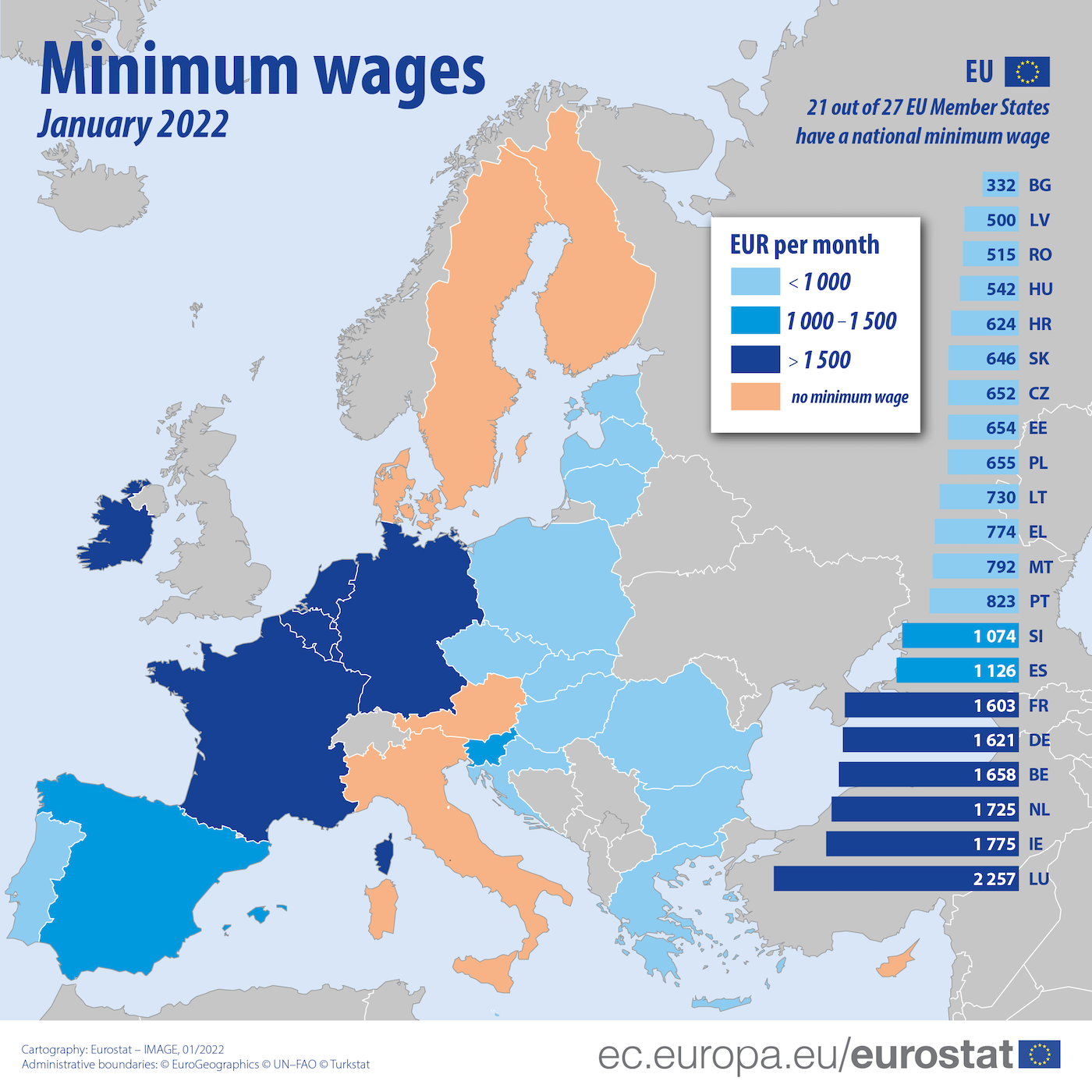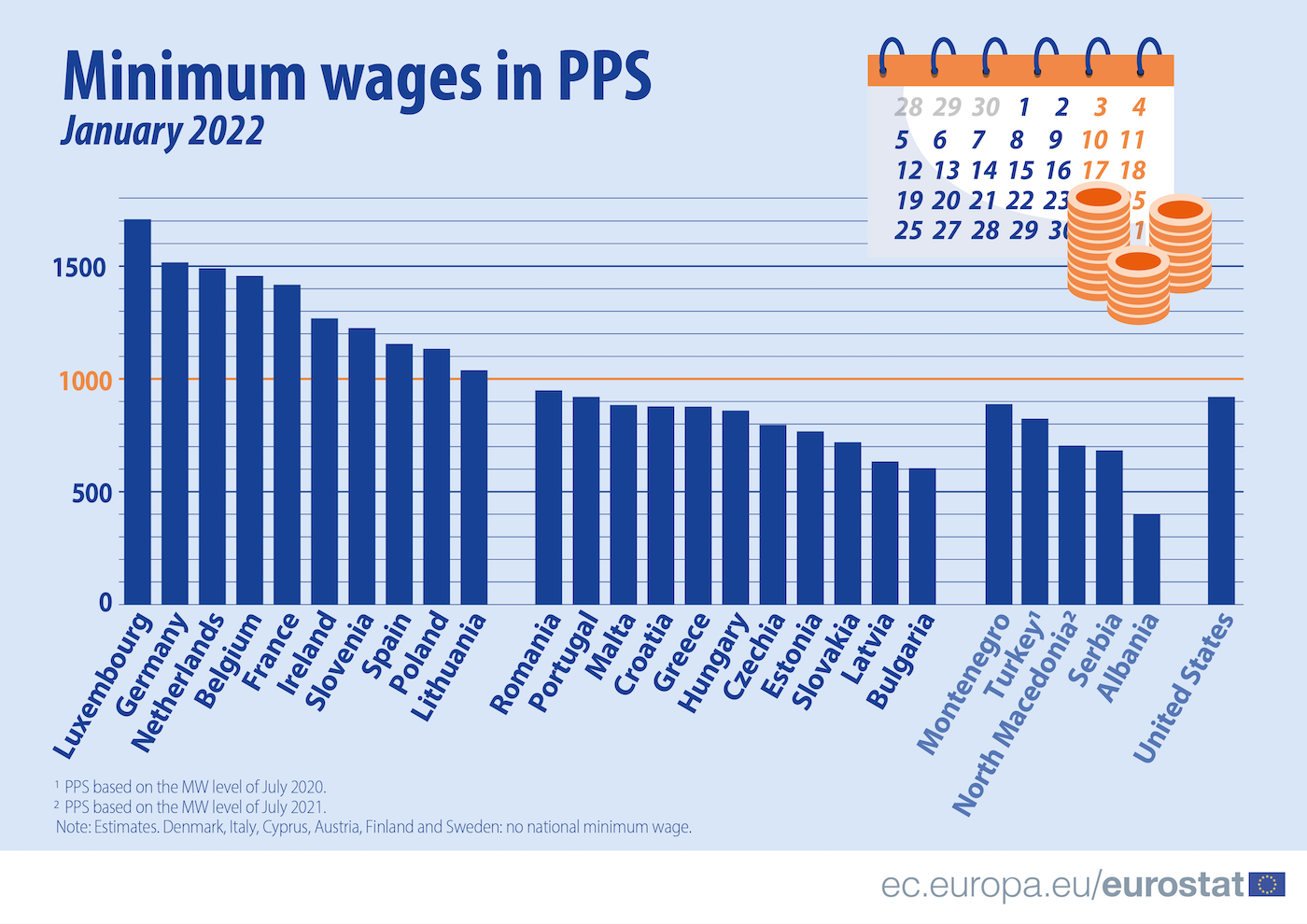As of 1 January 2022, 21 out of the 27 EU Member States have national minimum wages, making Denmark, Italy, Cyprus, Austria, Finland and Sweden the exceptions. Based on their levels in euro, those 21 Member States can be divided into three main groups.
Monthly minimum wages below €1 000 in 13 EU countries, above €1 500 in 6
The 21 EU Member States that have national minimum wages can be divided into three main groups based on their levels in euro.
In January 2022, 13 Member States, located in the east and the south of the EU, had minimum wages* below €1 000 per month: Bulgaria (€332), Latvia (€500), Romania (€515), Hungary (€542), Croatia (€624), Slovakia (€646), Czechia (€652), Estonia (€654), Poland (€655), Lithuania (€730), Greece (€774), Malta (€792) and Portugal (€823).
In Slovenia (€1 074) and Spain (€1 126) minimum wages ranged just over €1 000 per month, while in the remaining six Member States, minimum wages were above €1 500 per month: France (€1 603), Germany (€1 621), Belgium (€1 658), the Netherlands (€1 725), Ireland (€1 775) and Luxembourg (€2 257).
For comparison, the federal minimum wage in the United States was €1 110 in January 2022.
This information comes from data on minimum wages published by Eurostat today. The article presents a handful of findings from the more detailed Statistics Explained article.
Source dataset: earn_mw_cur
Smaller gaps in minimum wages once price level differences are eliminated
Across the group of 21 Member States in analysis, the highest minimum wage was almost 7 times higher than the lowest. However, the disparities are considerably smaller once price level differences are taken into account. When expressed in purchasing power standard (PPS), minimum wages in the Member States with lower price levels become relatively higher compared with those in the Member States with higher price levels.
By eliminating price differences, minimum wages ranged from 604 PPS per month in Bulgaria to 1 707 PPS in Luxembourg, meaning that the highest minimum wage was almost 3 times higher than the lowest. Based on this, it is possible to distinguish two main groups: group 1 with a national minimum wage above PPS 1 000, and group 2 with a national minimum wage below PPS 1 000.
Group 1 includes Luxembourg, Germany, the Netherlands, Belgium, France, Ireland, Slovenia, Spain, Poland and Lithuania. Their national minimum wages ranged from PPS 1 038 in Lithuania to PPS 1 707 in Luxembourg. While group 2 includes Romania, Portugal, Malta, Croatia, Greece, Hungary, Czechia, Estonia, Slovakia, Latvia and Bulgaria.
The national minimum wages for this group ranged from PPS 604 in Bulgaria to PPS 949 in Romania.
All candidate and potential candidate countries with a national minimum wage belong to group 2, with minimum wage levels ranging from PPS 401 in Albania to PPS 888 in Montenegro. The United States (PPS 920) belong to group 2.
Source dataset: earn_mw_cur
* Before any tax and social security contributions are deducted
For more information:
- Eurostat Statistics Explained article on minimum wage statistics
- Eurostat dedicated section on earnings
- Eurostat database on earnings
To contact us, please visit our User Support page.
For press queries, please contact our Media Support.



